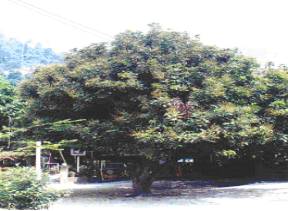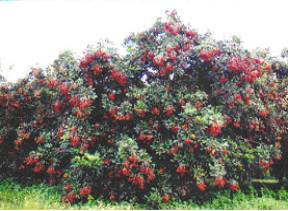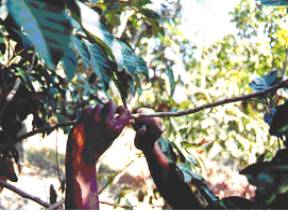Many trees are still grown from seed (Plate 1), but commercial production comes mostly from clonal or grafted trees (Plate 2).

Plate 1 A tree grown from seed
Rambutan seeds, after removal from the fruit and thorough washing, should be planted horizontally with the flattened side downward in order that the seedling will grow straight and have a normal, strong root system. Seeds will germinate in 9 to 25 days, the earlier, the more vigor in the seedling. The rate of germination of 2-day-old seeds is 87% to 95%. A week after seed removal from the fruit, there may be only 50% to 65% germination. Sun-drying for 8 hours and oven-drying at 30º C kills seeds within a week. Washed seeds will remain viable in moist sawdust or charcoal for 3-4 weeks, and some will even sprout in storage. The juice of the flesh inhibits germination. So, unwashed seeds or seeds treated with the juice can be held for a month in moist sawdust without sprouting. Rambutan seedlings bear in 5-6 years, but the ratio of female to male trees is low, sometimes over 50% of the trees are male , which do not bear fruit.

Plate 2 A grafted trees
To produce clonal trees nurseries use the modified Forkert budding (patch budding), taking seeds from seedling trees to produce the rootstocks. Seeds are pre-germinated and the seedlings are raised in intensive-care beds under shade for about 2 months before being transplanted to the nursery rows. The stocks are budded within a year; to stimulate active growth, the nursery rows and the mother trees receive water and nitrogen before budding. Budwood is defoliated 10-14 days before use to trigger the development of the axillary buds. Budding before flowering is avoided as it results in many flowering budlings. Budded trees flower 2 1/2 to 3 years after planting in the field. Most of the commercial clones are hermaphrodite having high proportion of functional female flowers and small percentage of functional flowers.
Alternatively, seeds are germinated in shaded sand- beds until they attain the 2 leaf cotyledon stage and then transferred into polythene bags, of 0.06mm gauge and measuring 25cm x 30cm. These rootstock seedlings are ready for grafting when they are about 8 months old and have a stem diameter of 1.5-2.5 cm.
Home gardeners often propagate young watershoots by air layering (Plate 3). Such marcots root well, but losses after separation and during field establishment tend to be excessive. Inarching of rooted stocks into twigs of the mother tree is a good but laborious propagation method.

Plate 3: Air- layering method
Marching is very effective onto 5- to 9-month-old seedlings of rambutan or of pulasan (N. mutabile ) or N. intermedium , but is a rather cumbersome procedure. After 2 or 3 months, the scion is notched 3 times over a period of 2 weeks and then severed from the parent tree. In general, rambutan is difficult to root using cuttings, although several partially successful techniques have been reported. Plants rooted from cuttings, however, are generally lacking in vigour. As such these cuttings are not recommended as a viable method for rambutan propagation.
|

